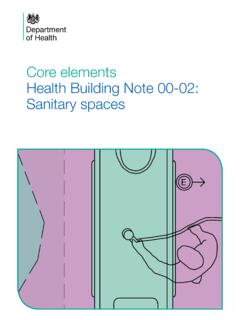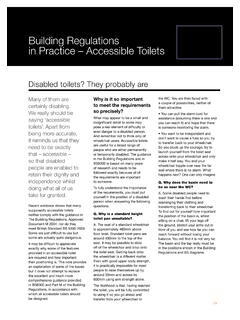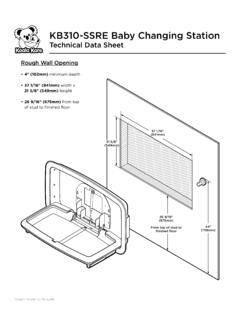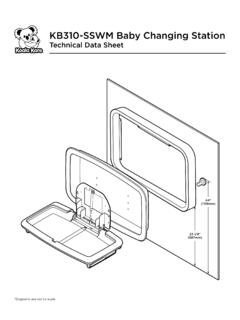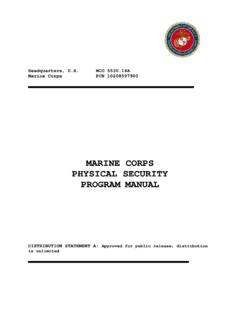Transcription of Waste Management Guidance Notes for Residential …
1 This document provides Guidance on the Waste storage and collection requirements that should be considered for Residential developments in Southwark. Following this Guidance is integral to satisfying the requirements for Waste facilities in the Sustainable Design and Construction supplementary planning Guidance (SPG) section Waste Management Guidance Notes for Residential developments February 2014 Waste Management Guidance Notes for Residential developments CONTENTS 1. Using this guide 2. Residential premises: Individual refuse facilities Communal refuse facilities Internal storage Garden Waste and composting 3.
2 Clinical and hazardous Waste 4. Specifications: Access specifications Storage specifications 5. Further information and required reading 6. Bin and vehicle types and dimensions 1. USING THIS GUIDE Section 2 of this guide contains information on the likely Waste arising per week for a range of different types of development. Using the bin sizes information in section 6, this can be used to estimate the number and type of bins which will be required to accommodate refuse / recycling: Number of bins required = volume of refuse or recycling (L) capacity of the bin From this, and details of bin dimensions also in section 6, the area needed to house the requisite bins can be calculated.
3 Section 4 contains important information about where refuse and recycling storage should be sited and considerations for access which should be used in determining where to site the refuse and recycling facilities and access arrangements. Disclaimer: These Notes are intended for Guidance only 2. Residential Two categories are used to specify storage capacity requirements for residual Waste and recycling within Residential properties: Individual properties and smaller developments (individual bin storage is provided for each property) Purpose built blocks of flats and large developments (communal bin storage is provided).
4 Residential premises with individual refuse facilities As of October 2011, the majority of street based individual houses will be receiving the following configuration of receptacles: A 240 litre wheeled bin for mixed dry recycling (properties without space for a wheeled bin for recycling will instead be provided with an appropriate number of stackable 55 litre blue boxes in its place) Waste Management Guidance Notes for Residential developments A 240 litre wheeled bin for refuse If appropriate, a 240 litre wheeled bin for mixed food and garden Waste (any properties without the need/space for a garden Waste wheeled bin will instead be provided with a 23 litre bin for food Waste collections).
5 Space must be provided for all the above requirements at the front of any new properties. Any properties with a private garden should also be provided with space for a compost bin. Collections for food and garden Waste will be weekly. Dry recycling and refuse collections will be on an alternate weekly basis Residential premises with communal refuse facilities The following formula is used to calculate the estimated total weekly refuse (recyclable and non-recyclable) arising from a Residential development with communal refuse facilities: Total weekly refuse (L) = 30L per unit + 70L per bedroom It is recommended that space be provided for recycling bins to accommodate 50% of this total weekly volume.
6 This is in line with the revised British Standard (BS5906 Waste Management in Buildings). Refuse (or residual Waste ) provision is required for 75% of the total weekly refuse arising: Recycling provision (L) = Total weekly refuse (L) x Residual Waste provision (L) = Total weekly refuse (L) x If the total weekly refuse is 1000ltr, we would require 500ltr capacity for recycling and 750ltr capacity for residual Waste . Any planned Waste capacity over 660ltr will require the use of communal bins Southwark operates a commingled recycling service from our communal recycling bins. The following can all be recycled together in one container: Paper and cardboard Cans, food tins, aerosols, and foil Glass bottles and jars Plastic bottles, foodtrays and pots Food and drink cartons, Tetra Pak Adequate storage to accommodate the above should be provided as a minimum.
7 Details of all the recycling and refuse containers available from the council to help you meet the capacity requirements discussed above can be found at section 6. In addition to the traditional container options outlined in section 6, developers may wish to look at further options for storage of their Waste pending collection. Any non-standard collection methods of collection or storage of Waste , use of compactors, vacuum-based technology, or roll-on, roll-off skips, should be discussed with our operations team prior to planning in. Waste Management Guidance Notes for Residential developments Internal storage To help residents to actively move towards a culture of recycling wherever possible, we encourage architects / designers to provide space (typically in the kitchen area of each property) for residents to be able to separate out Waste into two different containers - one for recyclable and one for non-recyclable Waste .
8 Wherever possible, depending on whether it is operational possible and subject to risk assessments on fire and safety grounds, residents in flats or apartments can benefit from the council s weekly clear bag recycling doorstep collection scheme. Designs for walkways and corridors should incorporate sufficient space for clear bags to be left outside the resident s doorway on the day of collection. In suitable Residential developments, and again where operationally feasible, refuse collection may also be on a door-to-door basis once a week, rather than using communal facilities. Storage spaces on corridors for refuse containment prior to day of collection should also be designed in to be included on each floor.
9 Additionally, within corridors and/or foyers of developments, spaces should be designed in for signage to promote recycling and refuse schemes. Organic Waste options within purpose built flats Purpose built flats should consider on site in-vessel food Waste digesters storage space including maturing areas storage areas for communal food Waste containers; storage space inside kitchens for seven litre containers food Waste disposal units (underneath sinks) sufficient space to accommodate wormeries on balconies. Storage for bulky articles Southwark operates a bulky Waste collection service for its residents.
10 Separate accommodation at ground level should be provided for the storage of large items such as white goods and furniture, prior to special collection by our bulky Waste crews. This site should include an area for signage detailing the options and procedures for disposal of bulky Waste . By the terms of the council s bulky Waste service, items may only be put out on the day of arranged collection, and not before. 3. CLINICAL AND HAZARDOUS Waste Clinical Waste Where clinical Waste is likely to be generated separate storage and collection arrangements for clinical Waste will need to be considered.

